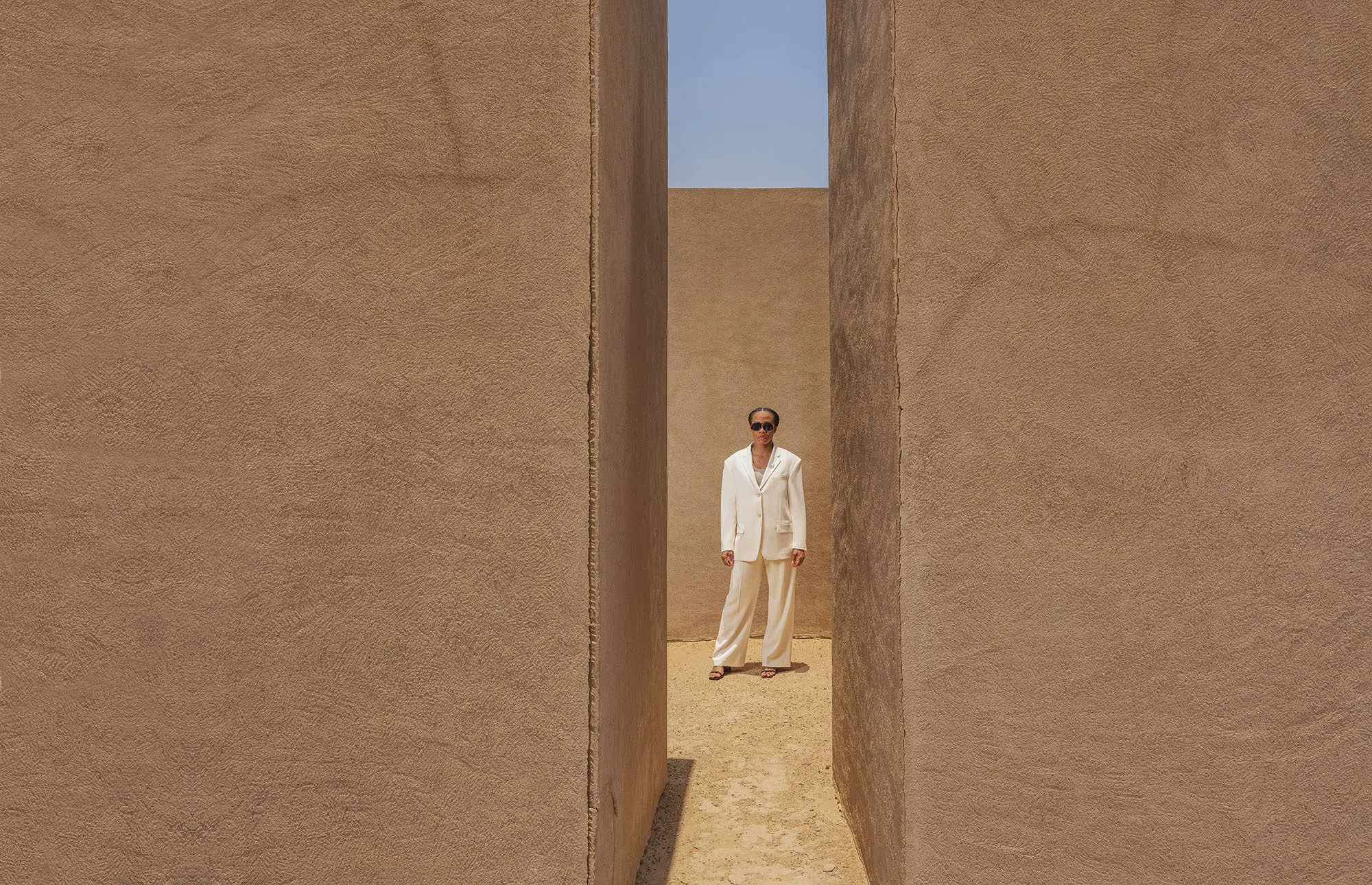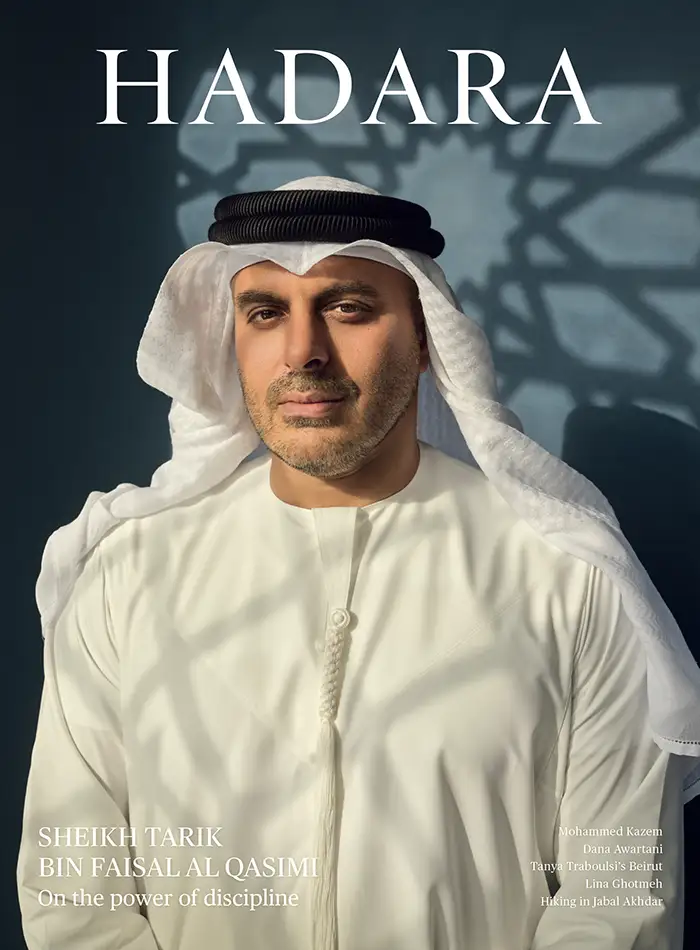Building Respect
Sustainability and use of local know-how are at the heart of Tosin Oshinowo’s approach to architecture. As curator of the second Sharjah Architecture Triennial, the Nigerian architect explores adaptability on a global scale.
By Charles Shafaieh
Photographs by Katarina Premfors
In 2015, Boko Haram destroyed the village of Ngarannam in northeast Nigeria. But last October, its 3,000 residents began to return to their land, where a new settlement designed by architect Tosin Oshinowo is in its final construction phase. Overseen by the United Nations Development Programme, the masterplan—the first UNDP Nigeria project led by an architect—features over 500 houses, a school, market stalls, a hospital, a police station, and solar-powered streetlights. Oshinowo took pains to respect the region’s predominant Kanuri culture. From the roof of the marketplace inspired by the Borno caps worn by men in the region to the adaptation of the zaure, a reception room in Kanuri homes that divides private and public life, the new Ngarannam gives an impression of coming home.
The project is a proof of concept for the philosophy that guides Oshinowo’s Lagos-based firm, cmDesign Atelier, which began life in 2012 as a solo venture and now employs a team of 10. A self-described “child of modernism,” she appreciates the movement’s respect for clean, simple lines and its emphasis on light and natural materials. However, she diverges from many of them in her emphasis on local materials, design typologies, use of space, and traditions. She calls her variation on modernism “Afro-minimalism” in recognition of how African cultures have utilised these principles for centuries, in contrast to imposed foreign notions about how indigenous people should live.

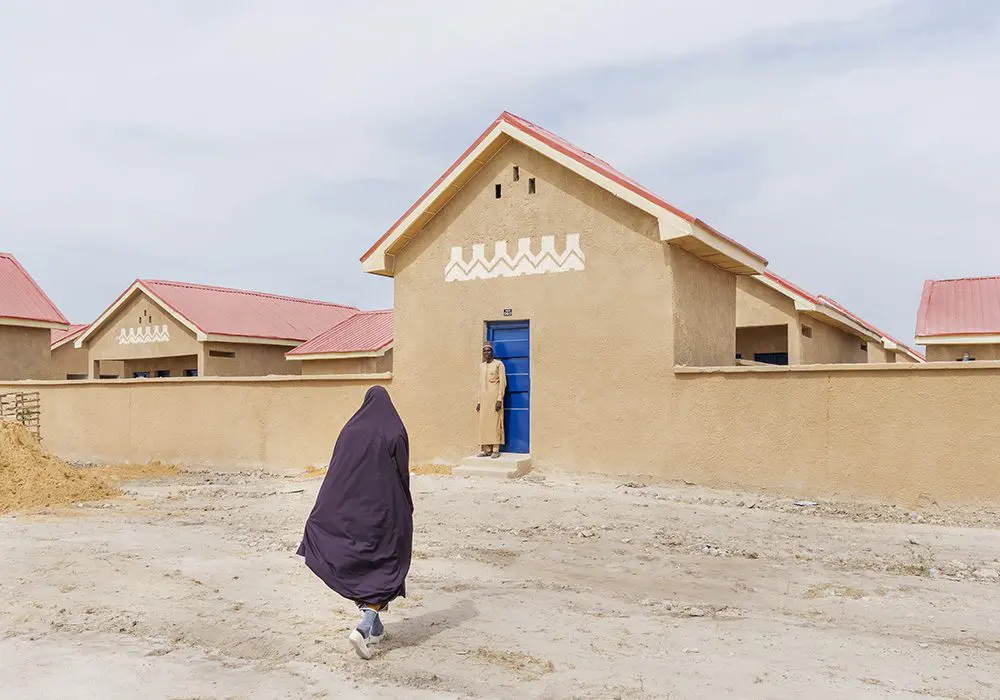
Oshinowo is guided by ‘human-centred design.’ In Ngarannam, she designed a settlement closely aligned with Kanuri culture, suited to cultural, environmental and climatic needs. It was important to be respectful to the way of life that existed before the insurgency. Photos: UNDP/Tolulope Sanusi. Oshinowo photo: Suit by Theory courtesy Bloomingdale’s Dubai @bloomingdalesme; Shoes: By Far @byfar_official.
Architecture has been Oshinowo’s passion since childhood. When she was 12, she accompanied her father, a doctor, on visits to the home he was having built in Ikorodu and even sketched its terrazzo floor. Her contemporary beliefs about design developed when she returned to Nigeria in 2009, having left at 16 to pursue her education in the UK and working at Skidmore, Owings and Merrill in London and at Rem Koolhaas’s OMA in Rotterdam. She discovered that the methods she had been taught—structured, with an emphasis on high design—could not be applied unadulterated in her own country. She saw that success can only be achieved by understanding a location’s needs and accepting its limitations.
Contrary to her initial impressions, the challenges of working and living in Nigeria energise rather than impede her. “Once I acknowledged this, it became an opportunity to push my creativity,” she says from her office in Lagos. “There’s always a solution. There’s always a way to make things happen in your context. If you spend too much energy thinking about all the things you can’t do, you’re going to miss opportunities.” This is evident in her firm’s diverse portfolio, from beach houses and Lagos’s Maryland Mall to places of worship and, most recently, the first flagship Adidas store in West Africa.
“People say that only architects understand what other architects say. I have an issue with this. Design should be inclusive.”
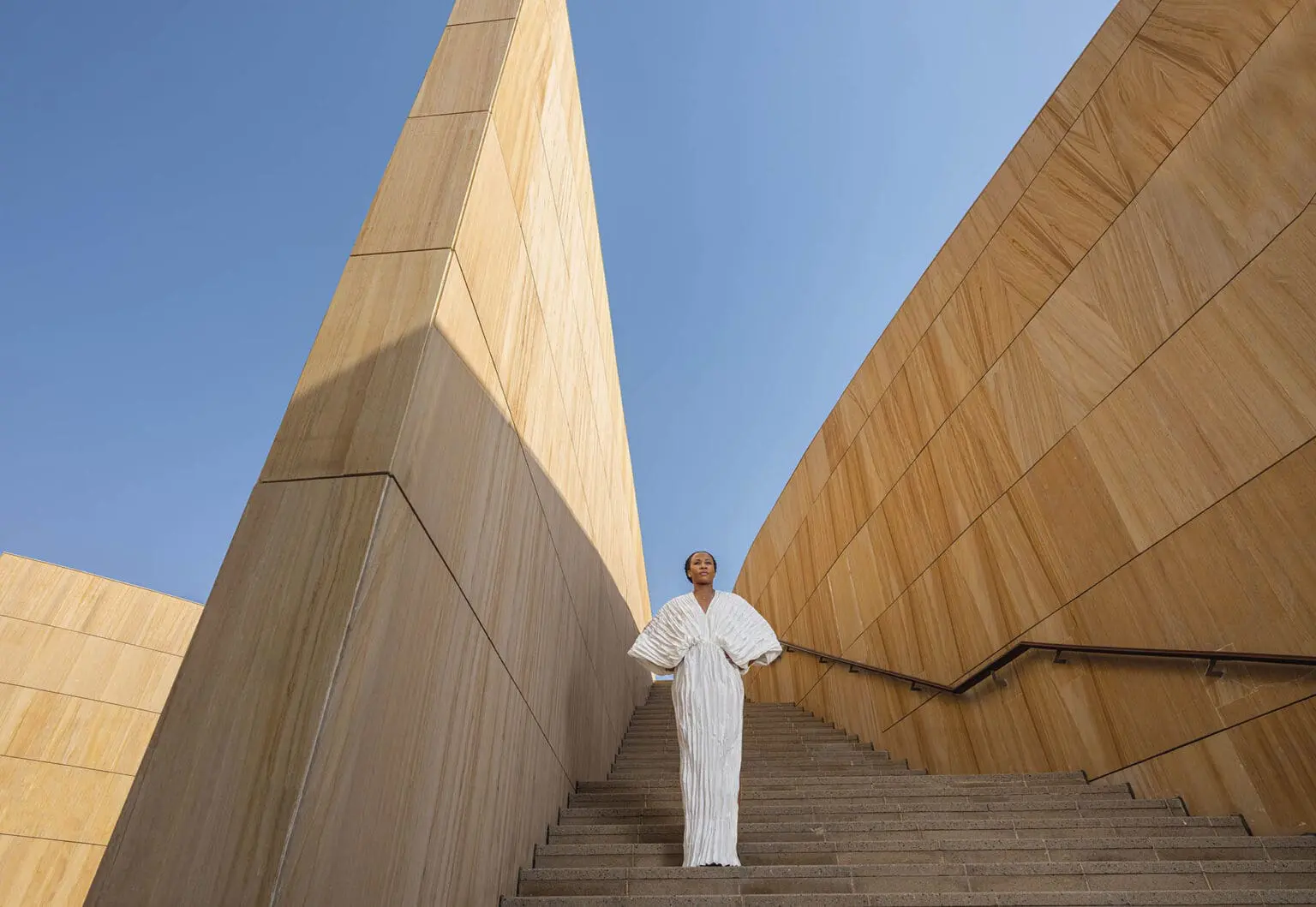
Photo: Katarina Premfors. Dress by L’IDEE courtesy Bloomingdale’s Dubai @bloomingdalesme; Shoes: By Far @byfar_official.
Had she been pessimistic, she may never have become an architect. The only Black student in many of her classes and a woman in a male-dominated field, she knows that she has often been “the odd one.” But it didn’t hinder her. “I was brought up in a household where self-reliance was very important,” she says. “My father would say to me and my sisters things like, ‘Don’t expect anything at the end of this gravy train. The only thing I’ve given you is a good education, so go and apply yourself.’ I feel very strongly that this is the only thing a parent can give and am very particular about it with my daughter. If you have a good education, no matter what happens you should be able to sort yourself out.”
Failure, she suggests, only arises when the metric on which you base success is imported. This is relevant not just in Nigeria but across the Global South, whose traditions have long been belittled or eliminated as a result of colonialism. “Instead of using somebody else’s measuring tools, we should celebrate the fact that our own tools are different. We should stop referencing ourselves and our innovations against somebody else’s system. By looking inwards, we realise how much we actually have.”
These under-appreciated innovations will be the focal point of the second Sharjah Architecture Triennial, which begins in November, curated by Oshinowo. Its theme, “The Beauty of Impermanence: An Architecture of Adaptability”, will explore the links between scarcity, creativity, and design, reframing the conversation about “sustainability” and “progress.” The most severe problems facing humanity today—including climate change, energy and food scarcity, and pandemics—are not localised. The Global North is only beginning to experience the conditions with which the Global South has long been familiar, and it needs to learn alternative ways to solve them. “We’ve always adapted. We’ve always created as much of a circular economy as possible, not because somebody said this is how to be more sustainable but because it’s just more practical,” Oshinowo says.
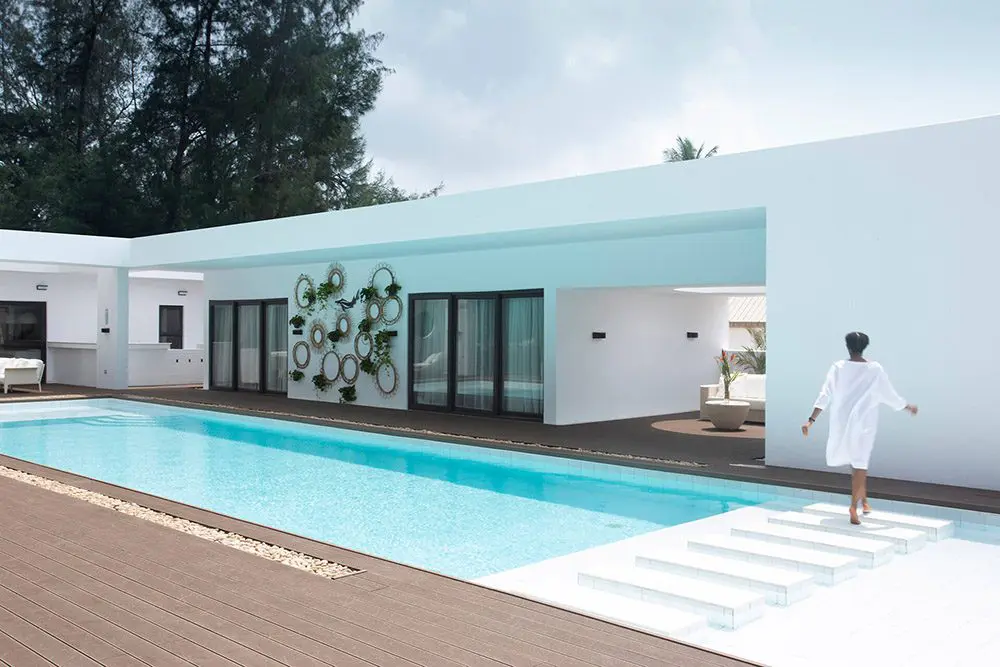
cmDesign Atelier’s Fowóralé House. In the past 20 years, Lagos’s beach has become a prime location for private beach houses. Photo courtesy of Tosin Oshinowo.
The Triennial provides an opportunity to highlight approaches from Angola to Vietnam concerning reuse, repair, and renewal. Oshinowo and her diverse advisory committee—including the Brazilian architect and urbanist Paulo Tavares, the Mumbai and Boston-based architect Rahul Mehrotra, and British-Nigerian artist Yinka Shonibare—selected 31 architects, studios and designers from 27 countries to explore innovative design solutions borne out of conditions of scarcity in the Global South. With an emphasis on climate consciousness, the event’s pavilions, workshops, public conversations, and publications will showcase the diversity of materials and methods designers might use, from sand to Nigerian weaving, to establish close links between cultures and their environments.
“Solutions have long existed in these societies that can address some of our challenges, whereas what has been considered ‘progress’ has really been a fundamental abuse of our finite resources,” she says when asked why she embraced the opportunity to curate. “It’s not what the canon suggests, but I strongly believe we need to look back to see how things were done and what worked.”
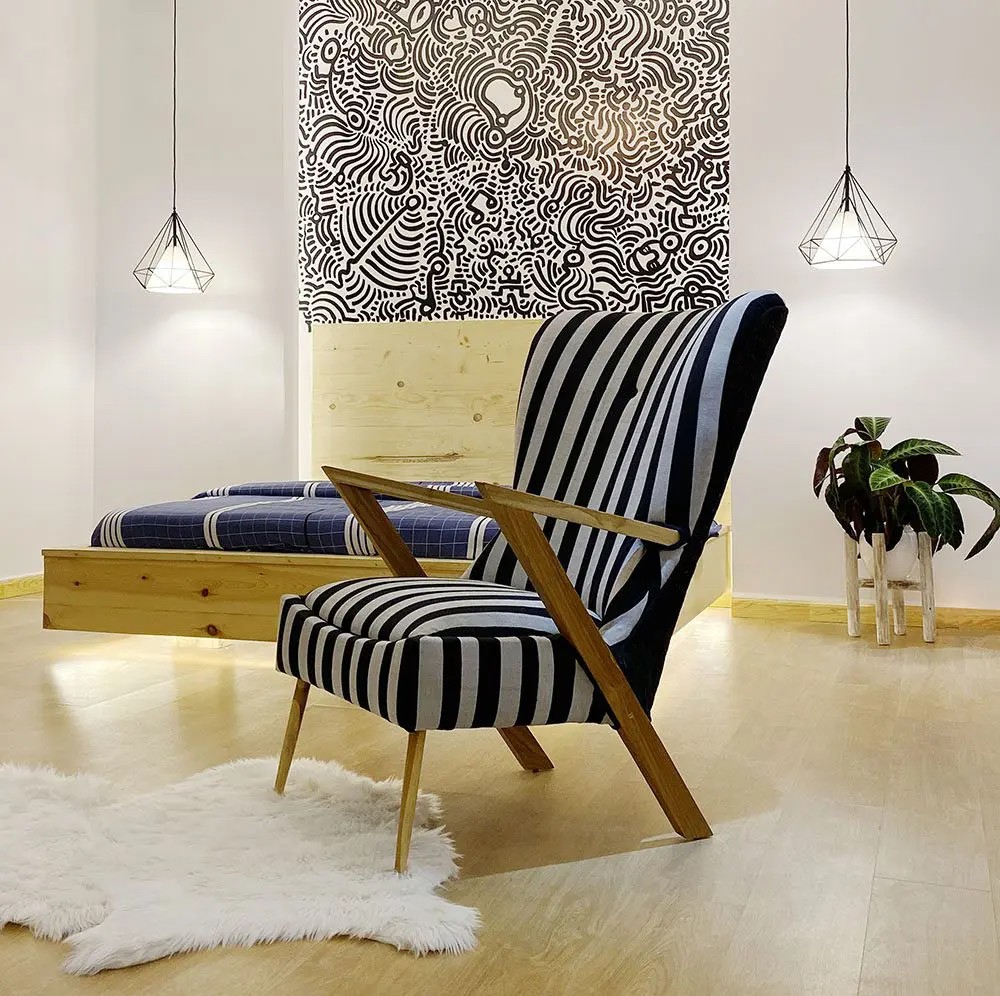
Ilé Ilà is a lifestyle furniture line producing handmade period-conscious furniture with contemporary African content. Shown here, Àdùnní. Photo: David Timibra.
Progress is not a universal concept, she says. “Technology means any form of innovation that exists within a period of time. The technology of building in the 1500s was technology; the technology of the 20th century was technology. But in our historical period, we only acknowledge ‘technology’ as something that happens in the future, or in the immediate future. That’s been a challenge, particularly when the idea of technology and progress are put hand in hand.”
She cites air conditioning in Nigeria as a prime example. “We have no business having it here, but the minute people become affluent, it’s the first thing that goes in,” she says. What she sees as equal parts ridiculous and unfortunate is the amnesia that has overtaken a society which either ignores or forgets that architecture in its past made such technology unnecessary. “Buildings designed in the 1950s and ’60s acknowledged the climate a lot more and worked at creating conducive environments in which to live. But when the ’70s came and all of a sudden air conditioning was available to the masses, it was culturally absorbed, regardless of whether it was practical or not—because it was associated with ‘progress’.”


First photo, Al Qasimiyah School—shown during the first Sharjah Architecture Triennial in 2019, with an installation by Bangkok studio all (zone)—will be a key location for SAT02. Second photo, Lexus collaborated with Oshinowo and Chrissa Amuah for a collection of headpieces that explored protection, celebration, functionality, and ornamentation. School photo: Marco Cappelletti / Sharjah Architecture Triennial. Mask photo: Minh T.
Industrialisation, via colonialism which spread its ideology and products, introduced the homogenisation of materials and solutions used in building and design. As a result, regional diversity, which Oshinowo champions, has steadily disappeared. And so, in Ngarannam she used a soil-cement blend for the homes’ exterior, its pinkish-brown tone echoing the vernacular aluminium roofs that she redesigned to improve air flow. The mixture creates aesthetic charm and, most importantly, can easily be fixed by residents, unlike wood, which is hard to maintain yet ubiquitous in cost-efficient structures across the Global North. Long term, the masterplan aspires to foster a practice of sustainability that emphasises education and repair.
This philosophy fuels her design projects, too. For a 2020 commission by Lexus for Design Miami, she and British-Ghanaian designer Chrissa Amuah collaborated on six face masks inspired by West African headpieces. They used an ancient bronze-casting technique alongside 3D printing to respect tradition while simultaneously reinventing it.
Her furniture line, Ilé-Ilà (“House of Lines” in Yoruba), similarly mixes cultures. Launched in 2017, it focuses on chairs—modern objects in African society, she says, as kings and chiefs would have been the only people to sit on them—fused with aso oke, a traditional Yoruba hand-woven cloth. Their bright colours and bold patterns provide a counterpoint to cmDesign Atelier’s clean lines and minimalist monochrome interiors.
Traditions make design easier to understand, a tenet Oshinowo has put at the core of her Triennial curation. “Everybody should be able to take something from it, to learn something that will influence how they think about things when they leave,” she says. “People say that only architects understand what other architects say. I have an issue with this. Design should be inclusive.”
Sharjah Architecture Triennial, The Beauty of Impermanence: An Architecture of Adaptability runs from 11 November 2023 to 10 March 2024.
Tosin Oshinowo was shot at MLEIHA ARCHAEOLOGICAL CENTRE in the Sharjah desert. The complex offers insight into a unique archaeological environment and the prehistoric sites in Mleiha, Jabal Buhais, and Jabal Faya.

